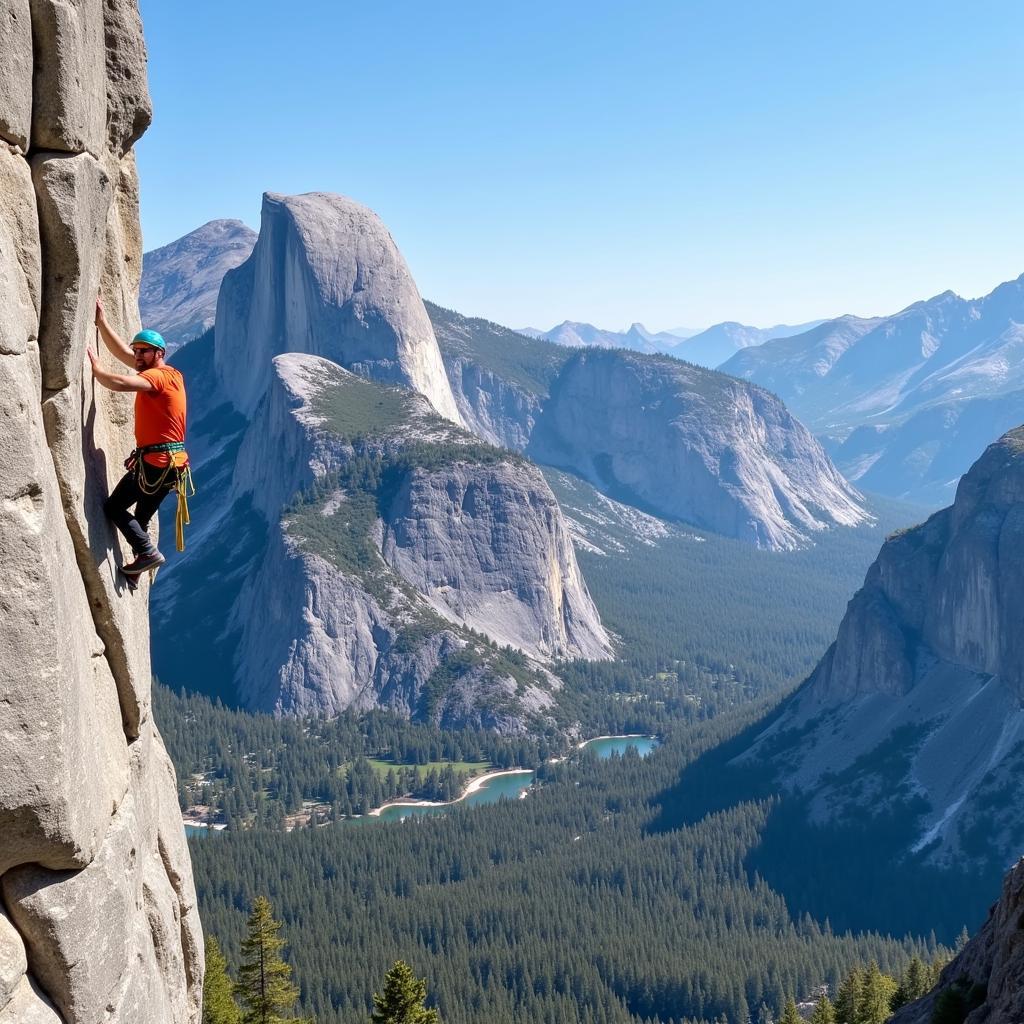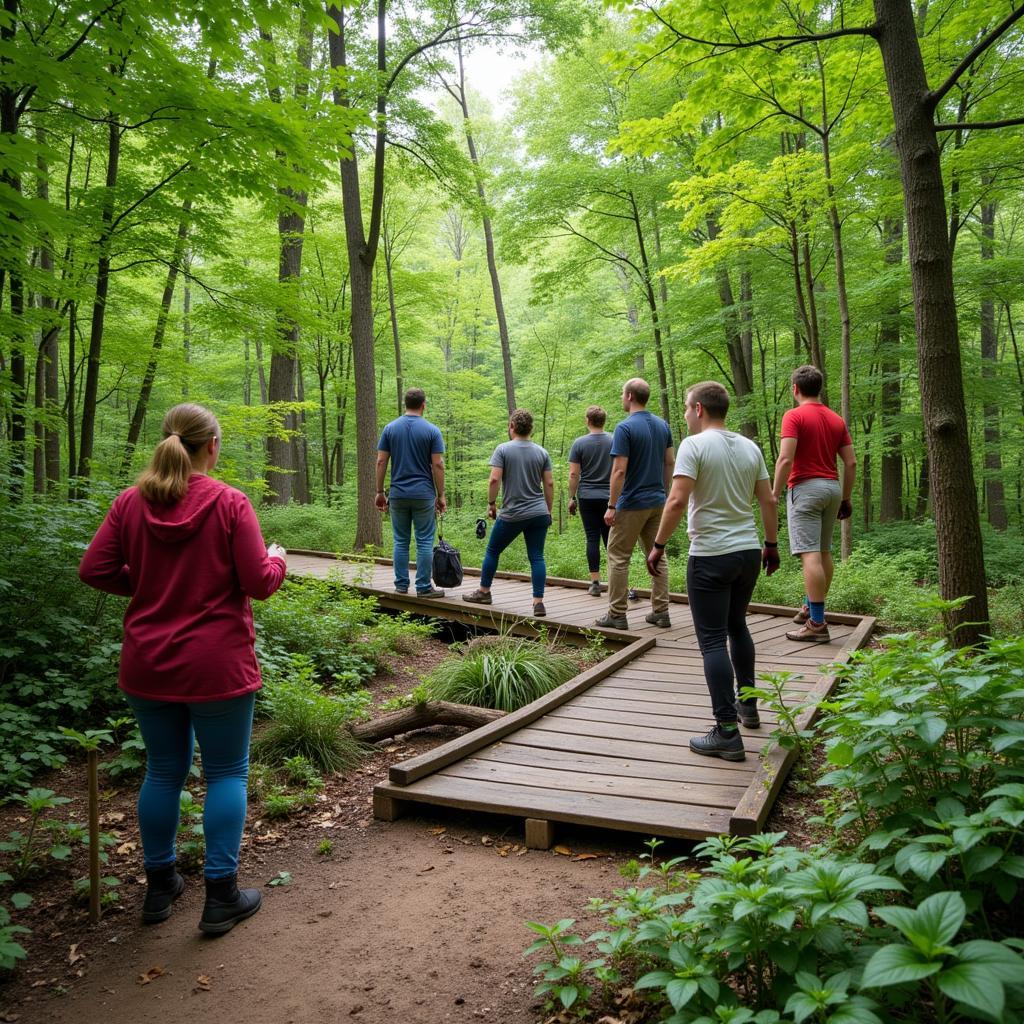The IELTS Speaking test often includes questions about leisure activities, hobbies, and personal experiences. One common topic that frequently appears is describing outdoor activities. This article will guide you through answering questions related to “describing an outdoor activity you want to try” in the IELTS Speaking test, providing sample answers and valuable tips to help you achieve a high band score.
Nội dung bài viết
- Part 1: Introduction and Interview
- Sample answer (Band 8-9):
- Part 2: Long Turn
- Cue Card:
- Sample answer (Band 8-9):
- Follow-up questions:
- Part 3: Two-way Discussion
- Examiner: How do you think outdoor activities benefit society?
- Sample answer (Band 6-7):
- Sample answer (Band 8-9):
- Examiner: Do you think the popularity of outdoor activities has changed over time? Why or why not?
- Sample answer (Band 8-9):
- Key Vocabulary and Phrases for High Scores
- Examiner’s Advice
Part 1: Introduction and Interview
In Part 1 of the IELTS Speaking test, the examiner may ask you some general questions about outdoor activities. Here are some possible questions and a sample answer for one of them:
- Do you enjoy outdoor activities?
- What kind of outdoor activities are popular in your country?
- How often do you engage in outdoor activities?
- What’s your favorite outdoor activity?
Let’s focus on question 4:
Sample answer (Band 8-9):
Examiner: What’s your favorite outdoor activity?
Candidate: My absolute favorite outdoor activity is hiking. I find it incredibly invigorating to immerse myself in nature, breathing in the fresh air and taking in breathtaking views of mountains and forests. It’s not just about the physical challenge, but also the mental clarity I gain from being away from the hustle and bustle of city life. I try to go on a hike at least once a month, and it’s always a rejuvenating experience that leaves me feeling refreshed and energized.
 Hiking trail with mountain and forest view
Hiking trail with mountain and forest view
Part 2: Long Turn
In this section, you’ll be given a cue card with a topic and some prompts. Here’s a sample cue card related to describing an outdoor activity you want to try:
Cue Card:
Describe an outdoor activity you want to try
You should say:
- What the activity is
- Where you would do this activity
- Why you want to try it
- And explain how you plan to prepare for this activity
Sample answer (Band 8-9):
The outdoor activity I’ve been eager to try is rock climbing. It’s an exhilarating sport that I’ve admired for quite some time but haven’t had the chance to experience firsthand yet.
I’m particularly interested in trying rock climbing at Yosemite National Park in California. The park is renowned for its majestic granite cliffs, especially El Capitan, which is a mecca for climbers worldwide. The sheer scale and beauty of these natural formations make it an ideal location for both beginners and experienced climbers alike.
The allure of rock climbing for me lies in its unique blend of physical and mental challenges. It requires not only strength and agility but also problem-solving skills and mental fortitude. I’m drawn to the idea of pushing my limits and overcoming fears, as well as the sense of accomplishment that comes from reaching the top of a challenging route. Moreover, the opportunity to connect with nature in such a profound way is incredibly appealing to me.
To prepare for this activity, I plan to take a systematic approach. First and foremost, I intend to enroll in a beginner’s rock climbing course at a local indoor climbing gym. This will allow me to learn the fundamental techniques and safety protocols in a controlled environment. I’ll also focus on improving my overall fitness, particularly my upper body strength and flexibility, through targeted exercises and yoga. Additionally, I plan to invest in proper gear, including climbing shoes, a harness, and a helmet, to ensure my safety.
Furthermore, I’ll familiarize myself with the specific challenges of outdoor climbing by reading guidebooks and watching instructional videos. I also hope to connect with experienced climbers who can offer advice and potentially accompany me on my first outdoor climbs. By taking these steps, I aim to approach rock climbing with respect for the sport and the environment, ensuring a safe and enjoyable experience when I finally attempt it at Yosemite.
 Rock climbing in Yosemite National Park
Rock climbing in Yosemite National Park
Follow-up questions:
- What are some potential risks associated with rock climbing?
- How popular is rock climbing in your country?
Sample answer for question 1 (Band 8-9):
Rock climbing, like any extreme sport, comes with inherent risks. The most obvious danger is the potential for falls, which can result in serious injuries or even fatalities if proper safety measures aren’t in place. Equipment failure is another critical risk, which is why it’s crucial to regularly inspect and maintain all climbing gear.
Additionally, environmental factors pose significant challenges. Sudden weather changes, rockfall, or encountering wildlife can create hazardous situations. There’s also the risk of overexertion or dehydration, especially on longer climbs or in hot conditions.
To mitigate these risks, it’s essential to have proper training, use appropriate safety equipment, and always climb with a partner. It’s also crucial to be aware of one’s limitations and to respect the environment. By approaching the sport with caution and preparation, many of these risks can be significantly reduced, allowing climbers to enjoy the thrill of the activity more safely.
Part 3: Two-way Discussion
In this part, the examiner will ask you more abstract questions related to the topic. Here are some possible questions and sample answers:
Examiner: How do you think outdoor activities benefit society?
Sample answer (Band 6-7):
I think outdoor activities are good for society in many ways. First, they help people stay healthy by encouraging exercise and fresh air. This can reduce health problems and medical costs. Also, outdoor activities often bring people together, helping to build stronger communities. They can also teach important skills like teamwork and leadership. Finally, when people enjoy nature, they might care more about protecting the environment, which is good for everyone.
Sample answer (Band 8-9):
Outdoor activities play a crucial role in fostering a healthier and more connected society. On an individual level, they promote physical and mental well-being by encouraging regular exercise, exposure to nature, and a break from the sedentary lifestyle that’s becoming increasingly common in our digital age. This, in turn, can lead to reduced healthcare costs and increased productivity.
Moreover, outdoor activities often serve as a catalyst for social interaction and community building. Whether it’s team sports, group hikes, or community clean-up events, these activities bring people together, fostering a sense of camaraderie and shared purpose. This social cohesion is invaluable in building resilient communities.
From an educational perspective, outdoor activities provide experiential learning opportunities that are difficult to replicate in traditional settings. They can instill important life skills such as teamwork, leadership, problem-solving, and risk assessment.
Perhaps most importantly, engaging with the outdoors cultivates an appreciation for nature and environmental stewardship. As people develop a personal connection with natural spaces, they’re more likely to support conservation efforts and sustainable practices, which is crucial for addressing global environmental challenges.
In essence, outdoor activities contribute to creating a society that is not only healthier and more socially connected but also more environmentally conscious and resilient in the face of modern challenges.
 Group outdoor activity benefits for society
Group outdoor activity benefits for society
Examiner: Do you think the popularity of outdoor activities has changed over time? Why or why not?
Sample answer (Band 8-9):
The popularity of outdoor activities has indeed undergone significant changes over time, influenced by various social, technological, and environmental factors.
Historically, outdoor activities were often necessary for survival or tied to occupations. However, with urbanization and technological advancements, there’s been a shift towards viewing these activities as leisure pursuits. In recent decades, we’ve seen waves of popularity for different outdoor activities.
The rise of extreme sports in the 1990s and early 2000s brought activities like snowboarding, mountain biking, and rock climbing into the mainstream. This trend was fueled by media coverage, improved equipment technology, and a cultural shift towards seeking adrenaline-pumping experiences.
More recently, there’s been a resurgence in simpler outdoor activities like hiking, camping, and birdwatching. This can be attributed to several factors:
-
Increased awareness of the mental health benefits of spending time in nature, especially as a counterbalance to our increasingly digital lives.
-
Growing environmental consciousness, leading people to seek connections with the natural world.
-
The influence of social media, which has made sharing outdoor experiences more appealing and accessible.
-
Improvements in gear technology, making outdoor activities more comfortable and accessible to a wider range of people.
-
The COVID-19 pandemic, which led to a significant uptick in outdoor recreation as people sought safe, socially-distanced activities.
However, it’s worth noting that this increased popularity has also brought challenges, such as overcrowding in popular natural areas and the need for better education about outdoor ethics and safety.
Looking ahead, I believe we’ll continue to see evolving trends in outdoor activities, possibly with a greater emphasis on sustainable and low-impact pursuits as environmental concerns become more pressing. The key will be balancing the benefits of increased engagement with nature against the need to protect and preserve our outdoor spaces for future generations.
Key Vocabulary and Phrases for High Scores
To achieve a high band score in your IELTS Speaking test, it’s crucial to use a wide range of vocabulary and complex sentence structures. Here are some key terms and phrases related to outdoor activities that can help elevate your responses:
-
Exhilarating /ɪɡˈzɪləreɪtɪŋ/ (adjective): Very exciting and enjoyable.
Example: “Rock climbing is an exhilarating sport that combines physical challenge with mental focus.” -
To push one’s limits (phrase): To test the extent of one’s abilities or endurance.
Example: “Outdoor activities often allow you to push your limits and discover what you’re truly capable of.” -
Immerse oneself in nature (phrase): To become completely involved in or surrounded by the natural environment.
Example: “Hiking allows me to immerse myself in nature and escape the stresses of daily life.” -
Rejuvenating /rɪˈdʒuːvəneɪtɪŋ/ (adjective): Making one feel younger, more vital, or refreshed.
Example: “I find spending time outdoors to be incredibly rejuvenating for both my body and mind.” -
Cultivate an appreciation (phrase): To develop a deeper understanding and enjoyment of something.
Example: “Engaging in outdoor activities can help cultivate an appreciation for the environment and its preservation.” -
Environmental stewardship (noun): The responsible use and protection of the natural environment.
Example: “Participating in outdoor activities often leads to a greater sense of environmental stewardship.”
Remember to use these terms and phrases naturally and in context. Practice incorporating them into your responses to enhance the sophistication and fluency of your speech.
Check out our guide on how to describe a new hobby you are considering for more speaking practice tips.
Examiner’s Advice
To excel in the IELTS Speaking test, particularly when discussing outdoor activities:
-
Practice describing various outdoor activities in detail, focusing on your personal experiences or aspirations.
-
Develop a broad vocabulary related to nature, sports, and leisure activities. Use specific terms rather than general ones.
-
Work on your fluency by speaking about these topics regularly. Record yourself and listen back to identify areas for improvement.
-
Prepare to discuss both the benefits and potential drawbacks of outdoor activities to demonstrate critical thinking skills.
-
Use a variety of tenses when discussing past experiences, current interests, and future plans related to outdoor activities.
-
Incorporate idiomatic expressions and collocations naturally in your responses to showcase language proficiency.
-
Be prepared to extend your answers with examples, explanations, and personal opinions to fully demonstrate your English speaking skills.
By following these tips and consistently practicing, you’ll be well-prepared to tackle any question about outdoor activities in your IELTS Speaking test. Remember, the key is to speak confidently, use a range of vocabulary, and express your ideas clearly and coherently.
For more practice, try describing a natural wonder you want to see or an outdoor activity that energizes you.


